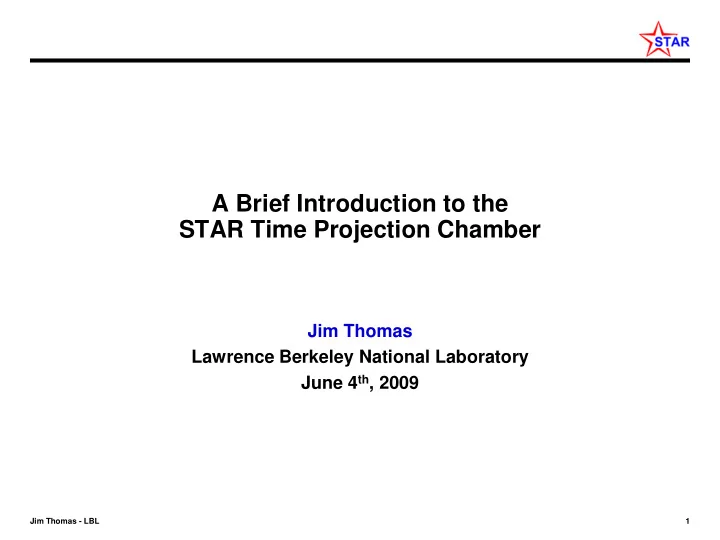

A Brief Introduction to the STAR Time Projection Chamber Jim Thomas Lawrence Berkeley National Laboratory June 4 th , 2009 Jim Thomas - LBL 1
The TPC Flies from LBL to BNL - Nov 6, 1997 In 2009, the FEE electronics was upgraded to TPX - see talk by T. Ljubicic Jim Thomas - LBL 2
Basic Size and Shape • 4.2 m long • 4 m dia • Cathode at midplane of TPC • 28 kV, norm • Readout on both ends Anode • planes, each with Inner & Outer sectors Jim Thomas - LBL 3
TPC Sector Detail • 24 sectors • 12 on each side • Large pads for good dE/dx resolution in the Outer sector Small pads • for good two track resolution in the inner sector 60 cm 190 cm See talk by Y. Fisyak Jim Thomas - LBL 4
Sector Repair is possible but not a trivial task Sector Installation & Tooling See talk by A. Lebedev Jim Thomas - LBL 5
TPC Sector Detail • Gating Grid • Ground Shield • Anode – 4 mm pitch, no field wires – Spacing: inner ≠ outer • Pad Plane Sector Operation for 20:1 signal to noise Sector anode gas gain voltage 3770 ± 10% inner 1170 1230 ± 10% outer 1390 See talks by A. Lebedev and R. Witt Jim Thomas - LBL 6
A few other anode facts • There are 8 HV channels and 6 RDOs 1 per sector – We can address anode wires by radius: Gain on, off, or lower the gain – HV almost coincident with RDO divisions on the outer sector Inner Outer – HV not coincident with RDO division in 0.1 the inner sector 1050 1150 1250 1350 Jim Thomas - LBL 7 Voltage
Field Cage: to short or not to short … • The field cage operates at 28 kV … limit is ~ 40 kV • Occasionally we will find a short between a pair of the Field Cage rings – Usually (magnetic) dirt • We had one permanent short on the East end – Its has been repaired We have an intermittent • short on the west end – Approx ¼ of a 2 M resistor • After a cluster of Main Magnet crashes this year we developed a full short – Approx ring 130 (out of 182) We have precision software to deal with these shorts See talks by G. Van Buren & J. Seele Jim Thomas - LBL 8
Gas • STAR uses P10 – Low Drift Field • 130 V/cm – Good Diffusion – DV at Peak of Curve – Easy to mix • He-Ethane was considered as an option – Good Diffusion – Lower MCS – But DV is low and requires a higher field – STAR designed for 85 kV – Practical limit ~40 kV • Other gases may be possible but choices limited by drift field and BNL health & safety reqs Jim Thomas - LBL 9
Gas System The existing gas system works well and could be extended to include H 2 O or Alcohol. We have no experience with this and don’t know what impact it will have on the TPC and internal components. Jim Thomas - LBL 10
Summer Shutdown: usually a very tight schedule STAR runs 24/7 for • 20-30 weeks per year • Typical schedule for shutdown period – Not a lot of time for R&D … or repair Jim Thomas - LBL 11
TPC Review 2006 • Charge – The review panel is asked to assess the ability of the STAR TPC, including planned upgrades of its front end electronics and readout, to meet the physics driven requirements of the experimental program in the high luminosity era at RHIC. Distortions - Pile up – Aging - R&D - Support for operations • Main Conclusions – [The TPC] will clearly remain the main tracking detector in STAR for the foreseeable future. The committee notes that RHIC has achieved continued luminosity improvements to within about a factor five of the maximum instantaneous luminosity ultimately envisioned for RHIC II. – In summary, the committee believes that the TPC can be operated and produce excellent physics results at the projected higher luminosities. Solving the problems of distortions and pileup continue to pose a challenge, but there appear to be no problems in principle to prevent success. See: http://indico.mppmu.mpg.de/indico/conferenceDisplay.py?confId=494 for a link to the 2006 presentations and the final report of the committee Password: star2009 Jim Thomas - LBL 12
BNL Science and Technology Review – Summer ‘08 • The ‘08 review panel asked us to look at high luminosity running at RHIC – The STAR collaboration should develop a program to study possible consequences (e.g., aging) of operating the TPC in a high luminosity environment. Progress should be documented and presented at the 2009 RHIC S&T review. • Nu Xu has asked you to help us address the long term future of the TPC • Charge – The [STAR] collaboration is also planning to install several new detectors whose installation will coincide, in time, with a significant increase in the luminosity of the beams at RHIC. – These upgrades will allow the collaboration to continue to do compelling physics for many more years but the usefulness of these new detectors will depend on excellent performance from the TPC. – Therefore, it is important to know if the TPC can meet the requirements of the experimental program in the high luminosity era at RHIC and if there are intrinsic lifetime or aging issues for the TPC that might affect how, or how long, it can run. Onward Jim Thomas - LBL 13
Recommend
More recommend